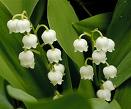
Lily of the valley is a herbaceous perennial and a member of the asparagus family, Asparagaceae, that also includes scilla, yucca, and hosta. It is native to Europe, except the Mediterranean and Atlantic margins, and has native varieties in Japan, parts of eastern Asia, and perhaps Eastern US. Plants thrive in moist shady areas and often spread by rhizomes to form large colonies.
Description: Plants grow to six to twelve inches tall and eight to 12 inches wide. They have two to three, lanceolate green leaves five to ten inches long with parallel veining and an erect or slightly arching flowering stem four to nine inches long in mid spring. Each stem bears on one side five to ten bell-shaped, sweetly fragrant, nodding white flowers that sometimes gives way to red berries with one to six seeds in the fall. Grown for its sweet smelling, delicate flowers, it is very popular for wedding bouquets. Many cultivars are available with double flowers, rose-colored flowers, variegated foliage, and differences in plant size.
Poisonous Properties: All parts of Lily of the valley contain a large group of cardiac glycosides including convallotoxin, convallarin, and convallamarinare and are very poisonous if eaten in large quantities with the red berries are especially appealing to children. Other glycosides, saponins, act with volatile oils as an irritant and even small amounts of the plant can result in burning sensation in the mouth, and throat, excessive salivation, abdominal pain, vomiting, diarrhea, irregular and slow pulse, reduced heart rate, blurred vision, drowsiness, cold clammy skin, dilated pupils, and red skin rashes but death due to ingestion is not well documented.